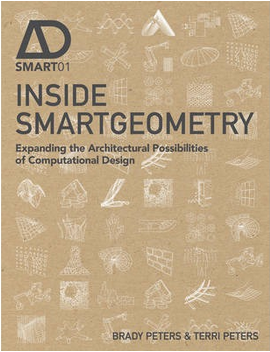
Inside Smartgeometry : Expanding the Architectural Possibilities of Computational Design
[BOOK DESCRIPTION]
Smartgeometry (SG) is a key influence on the architectural community who explore creative computational methods for the design of buildings. An informal international network of practitioners and researchers, the group meets annually to experiment with new technologies and collaborate to develop digital design techniques. When SG was founded in 2001 by London-based architects and friends Hugh Whitehead (Foster + Partners), J Parrish (AECOM) and Lars Hesselgren (PLP), there was little in the way of parametric tools for architecture. SG was founded to encourage the development, discussion and experimentation of digital design techniques driven by design intent rather than on construction specifications. SG calls for a re-consideration of the design process, where the creation of computational mechanisms become an integral part of designing - not a task done prior to or separate from the process. In the early years of the workshops this need for new ways of design thinking led to the development of Bentley's GenerativeComponents software.In recent years, the ecology of these design environments has diversified to include multiple software platforms, as well as innovative fabrication techniques and interactive environments. SG has grown accordingly from a handful of experts to an international network of designers who are defining the future of design. Founded by digital pioneers, it creates the algorithmic designers of the future. Inside Smartgeometry can be seen as a retroactive manifesto for SG, examining and contextualising the work of the SG community: the digital spaces, prototypes and buildings designed using bespoke tools created in response to architectural ideas. From interactive crowd-sourcing tools to responsive agent-based systems to complex digitally fabricated structures, it explores more than a decade of advances that have been influential for architecture. Through 23 original texts including reflections by the founders, and key contributors such as Robert Aish, Martin Bechthold, Mark Burry, Chris Williams and Robert Woodbury, the book offers a critical state of the art of computational design for architecture.Many international design and engineering firms have participated in SG and the book includes chapters by practitioners from offices such as CASE, Design2Production, Foster + Partners, Grimshaw, Populous and SOM.
[TABLE OF CONTENTS]
Foreword 6
Brett Steele
Introduction 8 (17)
Brady Peters
Terri Peters
The Origins of Smartgeometry 25 (14)
Hugh Whitehead
Lars Hesselgren
J. Parrish
First Build Your Tools 39 (20)
Robert Aish
Parametric Evolution 59 (2)
Branko Kolarevic
Matrix Architecture 61 (18)
Jenny E. Sabin
Metrics of Human Experience 79 (2)
Roly Hudson
Michael Westlake
Interacting with the Model 81 (820)
Neil Katz
Bess Krietemeyer
Tobias Schwinn
Responsive Design: Towards An Ecology of 901 (210)
Objects and People
Andre Chaszar
Anton Savov
Peter Liebsch
Sascha Bohnenberger
Design Flow and Tool Flux 1111(10)
Robert Woodbury
The Sound of Smartgeometry 1121(8)
Brady Peters
Design Exploration and Steering of Design 1129(12)
Axel Kilian
Geometry: How Smart Do You Have to Be? 1141(12)
Chris Williams
Generativecomponents and Smartgeometry: 1153(12)
Situated Software Development
Volker Mueller
Makai Smith
From Descriptive Geometry to Smartgeometry: 1165(10)
First Steps Towards Digital Architecture
Mark Burry
Exploring Human-Computer Interaction in 1175(10)
Design Process
Flora Salim
Przemek Jaworski
Designing Intelligence: Diy Robotics for 1185(10)
Responsive Environments
Nick Puckett
Encoding Design 1195(10)
Fabian Scheurer
Working Prototypes, Creating Knowledge 1205
Shane Burger
Xavier De Kestelier
Mind the Gap: Stories of Exchange 2217(14)
Designing Robotic Assemblies 2231(10)
Tobias Bonwetsch
The Practice of Smartgeometry 2241(12)
Hugh Whitehead
Digital Crafting: Performative Thinking for 2253(14)
Material Design
Mette Ramsgard Thomsen
Martin Tamke
Design Robotics: New Strategies for 2267
Material System Research
Martin Bechthold
Contributor Biographies 272

 新书报道
新书报道